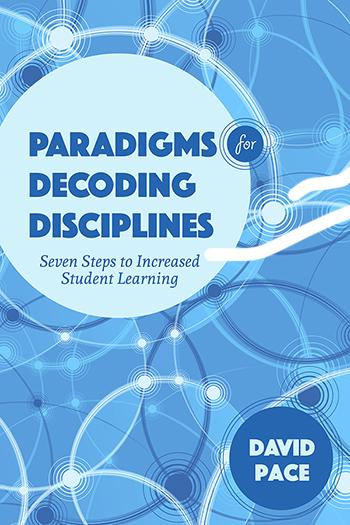Publications in the Scholarship of Teaching and Learning: David Pace
David Pace, Paradigms for Decoding the Disciplines: Seven Steps to Increased Student Learning (Bloomington, Indiana: Indiana University Press, In Press).
David Pace and Joan Middendorf, eds., Decoding the Disciplines: Helping Students Learn Disciplinary Ways of Thinking (New Directions in Teaching and Learning, Vol. 98 (Fall 2004).
David Pace and Sharon Pugh, Studying for History, (Harper Collins, 1995)
ARTICLES (Scholarship of Teaching and Learning)
“What’s feeling got to do with it? Decoding emotional bottlenecks in the history classroom,” Arts and Humanities in Higher Education,14 (April 2015) pp.166-180 (with Joan Middendorf, Jolanta Mickutė, Tara Saunders, José Najar, and Andrew E Clark-Huckstep)
“The History Learning Project ‘Decodes’ a Discipline” in Kathleen McKinney, ed., Ebbs, Flows, and Rips: The Scholarship of Teaching and Learning In and Across the Disciplines (Indiana University Press, 2013) (with Arlene Díaz, Joan Middendorf, and Leah Shopkow)
“Decoding Historical Evidence,” in David Ludvigsson, ed., Enhancing Student Learning in History. Perspectives on University History Teaching (University of Uppsala, Sweden: Swedish Science Press, 2012), pp.49-62.
“Prezi and Decoding of History,” in Quick Hits: Teaching with Technology (Indiana University Press, 2012.
“Assessment in History: The case for Decoding” the discipline, “Journal of the Scholarship of Teaching and Learning, Vol. 11, No. 3, August 2011, pp. 107 – 119.
“Just in Time Teaching in History” in Scott Simkins and Mark Maier, Just in Time Teaching Across the Disciplines (Sterling, VA.: Stylus Publishing, 2009). (with Joan Middendorf)
“Opening History’s ‘Black Boxes’: Decoding the Disciplinary Unconscious of Historians” in Carolin Kreber, ed., Teaching and Learning Within and Beyond disciplinary boundaries (London: Routledge, 2008), pp.96-104.
“The History Learning Project: A Department “Decodes” Its Students,” Journal of American History, Vol. 94, No. 4 (March 2008), pp.1211-1224. [Co-authored with Joan Middendorf, Leah Shopkow, and Arlene Díaz]
“The Internationalization of History Teaching through the Scholarship of Teaching and Learning,” Arts and Humanities in Higher Education, Vol.6, No. 3, (Fall 2007)
“Easing Entry into the Scholarship of Teaching and Learning through Focused Assessments: The “Decoding the Disciplines” Approach, To Improve the Academy (with Joan Middendorf) (2007)
“Making Thinking Explicit: A History Department Decodes Its Discipline,” National Teaching and Learning Forum, Vol.16, No.2 (February 2007) [Co-authored with Joan Middendorf, Leah Shopkow, and Arlene Díaz]
“The Scholarship of Teaching and Learning History Comes of Age: A New International Organization and Web Site/Newsletter,” History Teacher, Vol.40, No. 1 (November 2006), pp.75-78. [Co-authored with Keith Erekson]
“The Amateur in the Operating Room: History and the Scholarship of Teaching and Learning,” American Historical Review, Vol. 109, No. 4 (October 2004), pp. 1171-1192.
Articles included in Decoding the Disciplines:
“Decoding the Disciplines: A Model for Helping Students Learn Disciplinary Ways of Thinking,” pp.1-12. [Co-authored with Joan Middendorf]
“Decoding the Reading of History: An Example of the Process” pp.13-22.
“Learning to Use Evidence in the Study of History”, pp.57-66. [Co-authored with Valery Grim and Leah Shopkow]
“Using Collaborative Learning Teams to Decode Disciplines: Physiology and History” pp.75-84. [Co-authored with Whitney M. Schlegel]
“The Future of Decoding the Disciplines,” pp.109-110. [Co-authored with Joan Middendorf]
“Controlled Fission: Teaching Supercharged Subjects,” College Teaching, Vol. 51 Issue 2 (Spring 2003), pp. 42-45.
“Overcoming Cultural Obstacles to New Ways of Teaching: The Lilly Freshman Learning Project at Indiana University,” To Improve the Academy, Vol. 20 (2002), pp. 208-224 (with Joan Middendorf).
“Five Habits of Successful Students,” “Creating a Future,” “Raiding Virtual Libraries,” Assessing Basic Skills in a Discipline,” and “No Whining: The Value of One-Page Appeals” in Holly Stocking et al, eds., More Quick Hits: Successful Strategies by Award Winning Teachers (Bloomington, In.: Indiana University Press, 1998), pp. 59, 63, 82, 102-103, 107-108.
“Why Did the Chicken Cross the Screen? Cognitive and Emotional Considerations in Using Film to Teach About the Manhattan Project and Hiroshima” in John Lovell, ed., Shattered Dreams of the Good Life: Violence and the Oppressed, Insights from Film into Violence and Oppression (Westport Connecticut and London: Praeger, 1998, pp.113-125.
“Creating a Teaching Community among Graduate Students at a Research-Oriented University,” American Historical Association Perspectives (December 1997) (with Mary Cunningham, Stephen Kercher, and Meg Meneghel).
“Beyond ‘Sorting’: Teaching Cognitive Skills in the History Survey,” The History Teacher, Vol. 26, No.2 (February 1993), pp. 211-220.
“Structure and Spontaneity: Pedagogical Tensions in the Construction of a Simulation of the Cuban Missile Crisis” (with Bill Bishel, Roger Beck, Peter Holquist, and George Makowski), The History Teacher, Vol. 24, No. 1 (Nov. 1990), pp. 53-65.
